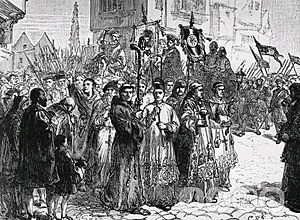Pilgrimage of Grace facts for kids
The Pilgrimage of Grace was a big protest that happened in York, Yorkshire, England in 1536. People were very upset about some major changes King Henry VIII was making in the country. They especially didn't like England leaving the Roman Catholic Church and the closing down of many monasteries. This protest was mainly focused around York, but similar uprisings happened across Northern England, starting with one in Lincolnshire a few days earlier.
Contents
What Was the Pilgrimage of Grace?
The Pilgrimage of Grace was a large uprising in northern England. It involved thousands of people. They were unhappy with King Henry VIII's religious changes. The name "Pilgrimage of Grace" suggests it was a holy journey. The protesters saw their actions as defending their faith.
Why Were People Upset?
There were several reasons why people joined this protest. Many felt their way of life was being threatened. They were worried about their religion and their local communities.
Leaving the Church
King Henry VIII wanted to divorce his wife, Catherine of Aragon. The Pope, who led the Roman Catholic Church, would not allow it. So, Henry decided to break away from the Pope's authority. He made himself the head of the Church of England. This was a huge change for many people. They had been Roman Catholic for centuries. They felt their traditional faith was being attacked.
Closing Monasteries
Another big reason for the protest was the Dissolution of the Monasteries. Monasteries were religious houses where monks and nuns lived. They also served as hospitals, schools, and places for the poor. King Henry VIII decided to close them all down. He took their land and wealth. This made many people angry. It meant losing important local services. It also meant losing places of worship and charity.
Other Problems
Besides religious changes, there were other issues. People were unhappy about new taxes. They also worried about changes to land ownership. Some felt the government was not listening to their needs. These problems added to the widespread discontent.
Who Was Involved?
The main leader of the Pilgrimage of Grace was a lawyer named Robert Aske. He was a respected figure in Yorkshire. Many ordinary people joined him. This included farmers, craftsmen, and even some nobles. They marched under banners showing religious symbols. This showed their strong faith.
What Happened During the Protest?
The protest started in Lincolnshire in October 1536. It quickly spread to Yorkshire. Robert Aske led a large group of rebels. They marched towards York and then to Pontefract Castle. This castle was a very important stronghold. The rebels managed to take control of it. They gathered a huge army, possibly up to 30,000 people. King Henry VIII was worried by the size of the rebellion.
The King's representatives met with the rebels. They promised to listen to their demands. They also offered a pardon for everyone involved. Robert Aske believed these promises. He told his followers to go home.
How Did It End?
Unfortunately, King Henry VIII did not keep his promises. After the rebels went home, smaller uprisings continued. The King used these as an excuse. He arrested Robert Aske and other leaders. They were charged with treason. Many were executed in 1537. This included Robert Aske. The Pilgrimage of Grace was put down. It showed the King's power. But it also showed how much people cared about their faith.
Images for kids
-
Plaque commemorating the Lincolnshire Rising, opposite south entrance to St James' Church, Louth
See also
 In Spanish: Peregrinación de Gracia para niños
In Spanish: Peregrinación de Gracia para niños





